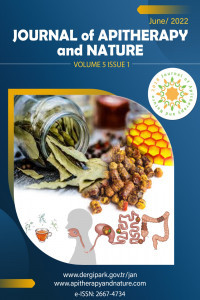GC-MS and UPLCA-PDA-TOF Profile of Polish and Eurasian Propolis
GC-MS and UPLCA-PDA-TOF Profile of Polish and Eurasian Propolis
Propolis, GC-MS, UPLCA-PDA-TOF,
___
- .
- Yayın Aralığı: Yılda 2 Sayı
- Başlangıç: 2018
- Yayıncı: Oktay YILDIZ
In Vitro Evaluation of Green and Red Propolis Extracts Against Candida spp
M. D. FREITAS, G. A. LOPES, N. A OLIVEIRA, B. M. ALMEIDA, S. R. L. ABREU, R. C. BASQUES, N. S. BINDA, S. M. FIGUEIREDO
Isolated Triterpenes from Stingless Bee Lisotrigona furva Propolis in Vietnam
Le Nguyen THANH, Vu Thi Kim OANH, Ha Thi THOA, Diep Thi Lan PHUONG, Nguyen Thi Phuong LIEN, Tran Huu GIAP, Nguyen Thi Minh HANG, Nguyen Van HUNG, Vassya BANKOVA
Ana Sofia P. FREITAS, Ana João P. GOMES, Ana CUNHA, Rui P. S. OLIVEIRA, Cristina ALMEIDA-AGUIAR
New Insights into Tropical Propolis: Propolis from Pitcairn Island
Boryana TRUSHEVA, Kristina GEORGIEVA, Milena POPOVA, Veselina UZUNOVA, Tihomira STOYANOVA, Violeta VALCHEVA, Rumiana TZONEVA, Vassya BANKOVA
Toothpaste with Propolis “Apident” Shows Antimicrobial Activity in vitro
Klemen RIHAR, Dunja Gregorič EXEL, Adriana PEREYRA, Rok KOPINČ, Bratko FILIPIČ
Water Extract of Propolis Might be Safer to Use During Pregnancy than Ethanol Extract
Al Mukhlas FIKRI, Ahmad SULAEMAN, Sri Anna MARLIYATI, Mokhamad FAHRUDIN
Cytotoxic Activity of Four Propolis Colombian Samples Against Canine Osteosarcoma Cells
Dolly Patricia Pardo MORA, Oscar Julián MURILLO, Mauricio Rey BUITRAGO, Mónica LOSADA, Jaime Fabian Cruz URIBE, Karina Basso SANTIAGO, Bruno José CONTI, José Maurício SFORCIN
Antimicrobial Effect of Commercial Propolis Extract (BEEO©)
Aslı Elif TANUGUR, Sevgi KOLAYLI, Merve KESKIN, Sengul ALPAY KARAOGLU
Flavonoids Constituents of Algeria Propolis
Segueni NARIMANE, Jesus. G. DIAZ, Akkal SALAH, Rhouati SALAH
The Influence of Propolis on Liver Pathology in Broilers
Maja MISKULIN, Ivana KLARIC, Matija DOMACINOVIC, Berislav PRAKATUR, Albina DUMIC, Daniela Cacic KENJERIC, İvan MISKULIN
